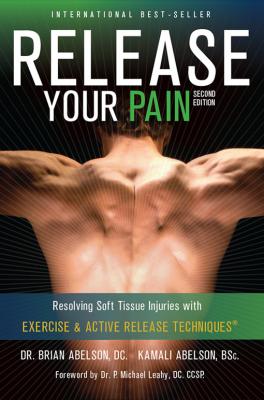ТОП просматриваемых книг сайта:
Release Your Pain: 2nd Edition - EBOOK. Dr. Brian James Abelson DC.
Читать онлайн.Название Release Your Pain: 2nd Edition - EBOOK
Год выпуска 0
isbn 9780987866219
Автор произведения Dr. Brian James Abelson DC.
Жанр Здоровье
Серия Release Your Body
Издательство Ingram
Repetitive Strain Injury caused by cumulative trauma has become the most prevalent cause of injuries within the workforce. RSIs are among the most misunderstood, misdiagnosed, and poorly-treated conditions in our health care system.
Common therapies such as medication, electric muscle stimulation, ultrasound, heat, ice, rest, and surgery have all failed to effectively resolve these repetitive strain injuries.
Active Release Techniques® (ART®) provides a means to effectively and rapidly resolve these repetitive strain injuries without surgical intervention, and, in most cases, allows you to quickly return to your normal activities. By combining ART with focused, specific exercises, 90% of RSI injury cases can be resolved.
Note: This book does NOT teach you how to perform Active Release Techniques (ART). ART can only be performed by a professional such as a Physiotherapist, Chiropractor, Occupational Therapist or some other type of musculoskeletal practitioner who is trained in these techniques. See www.activerelease.com for course details.
What is a Repetitive Strain Injury?
A repetitive strain injury is a soft-tissue injury in which muscles, nerves, ligaments, fascia, or tendons become irritated and inflamed, usually as a result of cumulative trauma and overuse.
Unlike strains and sprains, which usually result from a single incident (acute trauma), a repetitive strain injury develops slowly over time. Other names for such injuries include:
Cumulative Trauma Disorder (CTD).
Repetitive Motion Injury (RMI).
Occupational Overuse Syndrome (OOS).
Work-related Musculoskeletal Disorder (WMSD).
What Causes a Repetitive Strain Injury?
RSIs can occur in any occupation that requires repetitive action and can result through the overuse of some part of your body, in combination with any of the following factors:
Repetitive tasks with many small, rapid movements.
Insufficient rest time between the repetitive tasks.
Working in awkward or fixed postures for long periods of time.
Excessive and forceful movements, used repetitively, to move loads, or to execute accelerated actions such as lifting, running, hitting, or throwing.
Effects of Repetitive Actions on the Body
The development of a repetitive strain injury is often quite insidious. Most RSI injuries are the direct result of cumulative trauma, such as those experienced by computer users (who make up a large percentage of our RSI patients). Repeated keystrokes cause friction between tissue layers, resulting in small micro-tears and inflammation in the tissues of the hands, wrists, and forearms.
The body responds to this inflammation by laying down scar tissue in an attempt to stabilize the area. (This is somewhat like sewing a patch over a hole in our jeans in order to maintain the structure and integrity of the jeans.) This scar tissue binds these tissue layers together and inhibits the movement or “translation” of these tissue layers across each other. When this inhibition of movement is also accompanied by continued repetitive actions, it can cause even more friction between tissue layers, resulting in increased inflammation, and bringing about the formation of yet more scar tissue.
In addition, one often sees an increase in compressive force when soft tissues are bound together by adhesions. Tissues which are compressed together:
Inhibit nerve function.
Reduce lymphatic drainage.
Cause a decrease in blood flow and oxygen transfer to tissues.
Increase the production of fibroblasts (directly responsible for the formation of scar tissue).
Together, these create a multitude of additional circulatory, neurological, and musculoskeletal problems.
RSI: Who Suffers?
Repetitive strain injuries occur in all walks of life including:
Assembly line workers
Cashiers
Computer Operators
Computer Programmers
Construction Workers
Dental Technicians
Dentists
Golfers
Hairdressers
Homemakers
Hospital Workers
Massage Therapists
Meat Packers
Musicians
Nurses
Postal Workers
Runners
Tennis and Racquet Sport Players
Triathletes
Vehicle Operators
Weight Lifters
How Prevalent is RSI?
Repetitive Strain Injuries account for over 67 percent of all occupational injuries.1 Statistics show that the number of patients suffering from RSI has now surpassed those suffering from back pain. Repetitive Strain Injuries appear in all walks of life, in all types of occupations, and in all types of sports and physical activities.
RSI is particularly prevalent in activities where repetitive, high-force action is required. Nearly two-thirds of all reported occupational injuries are caused by the exposure of the upper body to repeated traumas. Individuals who are at high risk for RSI include those who have occupations that:
Combine force and repetition of the same motion, for long periods of time, especially in the fingers and hands.
Require work in awkward or unnatural positions.
Involve static work positions, while using the hands, arms, and shoulders, torso, or neck in an awkward position.
Combine continuous, precise muscular movements with the above-listed factors.2
In stressful economic times, it is common for employees to worry about whether they may be in danger of losing their jobs. This can result in workers putting in extra hours in an effort to make themselves look less expendable. In such situations, employees often expose themselves to increased risks of RSI injuries.
What is the Economic Impact of RSI?
With skyrocketing incidences of RSI, the health-care costs for RSI in the U.S. are now surpassing the costs for low-back pain as the largest health care expenditure.
According to the U.S. Bureau of Labor Statistics, approximately 260,000 carpal tunnel release operations are performed each year, with 47% of these

